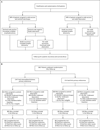Final trial report of sentinel-node biopsy versus nodal observation in melanoma
- PMID: 24521106
- PMCID: PMC4058881
- DOI: 10.1056/NEJMoa1310460
Final trial report of sentinel-node biopsy versus nodal observation in melanoma
Abstract
Background: Sentinel-node biopsy, a minimally invasive procedure for regional melanoma staging, was evaluated in a phase 3 trial.
Methods: We evaluated outcomes in 2001 patients with primary cutaneous melanomas randomly assigned to undergo wide excision and nodal observation, with lymphadenectomy for nodal relapse (observation group), or wide excision and sentinel-node biopsy, with immediate lymphadenectomy for nodal metastases detected on biopsy (biopsy group). Results No significant treatment-related difference in the 10-year melanoma-specific survival rate was seen in the overall study population (20.8% with and 79.2% without nodal metastases). Mean (± SE) 10-year disease-free survival rates were significantly improved in the biopsy group, as compared with the observation group, among patients with intermediate-thickness melanomas, defined as 1.20 to 3.50 mm (71.3 ± 1.8% vs. 64.7 ± 2.3%; hazard ratio for recurrence or metastasis, 0.76; P=0.01), and those with thick melanomas, defined as >3.50 mm (50.7 ± 4.0% vs. 40.5 ± 4.7%; hazard ratio, 0.70; P=0.03). Among patients with intermediate-thickness melanomas, the 10-year melanoma-specific survival rate was 62.1 ± 4.8% among those with metastasis versus 85.1 ± 1.5% for those without metastasis (hazard ratio for death from melanoma, 3.09; P<0.001); among patients with thick melanomas, the respective rates were 48.0 ± 7.0% and 64.6 ± 4.9% (hazard ratio, 1.75; P=0.03). Biopsy-based management improved the 10-year rate of distant disease-free survival (hazard ratio for distant metastasis, 0.62; P=0.02) and the 10-year rate of melanoma-specific survival (hazard ratio for death from melanoma, 0.56; P=0.006) for patients with intermediate-thickness melanomas and nodal metastases. Accelerated-failure-time latent-subgroup analysis was performed to account for the fact that nodal status was initially known only in the biopsy group, and a significant treatment benefit persisted.
Conclusions: Biopsy-based staging of intermediate-thickness or thick primary melanomas provides important prognostic information and identifies patients with nodal metastases who may benefit from immediate complete lymphadenectomy. Biopsy-based management prolongs disease-free survival for all patients and prolongs distant disease-free survival and melanoma-specific survival for patients with nodal metastases from intermediate-thickness melanomas. (Funded by the National Cancer Institute, National Institutes of Health, and the Australia and New Zealand Melanoma Trials Group; ClinicalTrials.gov number, NCT00275496.).
Conflict of interest statement
No other potential conflict of interest relevant to this article was reported.
Figures



Comment in
-
Clinical value of the sentinel-node biopsy in primary cutaneous melanoma.N Engl J Med. 2014 Feb 13;370(7):663-4. doi: 10.1056/NEJMe1313690. N Engl J Med. 2014. PMID: 24521113 No abstract available.
-
Melanoma: MSLT-1--SNB is a biomarker, not a therapeutic intervention.Nat Rev Clin Oncol. 2014 May;11(5):248-9. doi: 10.1038/nrclinonc.2014.64. Epub 2014 Apr 8. Nat Rev Clin Oncol. 2014. PMID: 24710577 No abstract available.
-
Melanoma: Why is sentinel lymph node biopsy 'standard of care' for melanoma?Nat Rev Clin Oncol. 2014 May;11(5):245-6. doi: 10.1038/nrclinonc.2014.65. Epub 2014 Apr 15. Nat Rev Clin Oncol. 2014. PMID: 24732941 Free PMC article.
-
Melanoma: MSLT-1--putting sentinel lymph node biopsy into context.Nat Rev Clin Oncol. 2014 May;11(5):246-8. doi: 10.1038/nrclinonc.2014.66. Epub 2014 Apr 15. Nat Rev Clin Oncol. 2014. PMID: 24732944 No abstract available.
-
Sentinel-node biopsy in melanoma.N Engl J Med. 2014 May 29;370(22):2149-50. doi: 10.1056/NEJMc1402989. N Engl J Med. 2014. PMID: 24869726 Free PMC article. No abstract available.
-
Sentinel-node biopsy in melanoma.N Engl J Med. 2014 May 29;370(22):2148. doi: 10.1056/NEJMc1402989. N Engl J Med. 2014. PMID: 24869727 No abstract available.
-
Sentinel-node biopsy in melanoma.N Engl J Med. 2014 May 29;370(22):2148-9. doi: 10.1056/NEJMc1402989. N Engl J Med. 2014. PMID: 24869728 No abstract available.
-
Sentinel lymph node biopsy in melanoma: final results of MSLT-I.Future Oncol. 2014 May;10(7):1121-3. doi: 10.2217/fon.14.67. Future Oncol. 2014. PMID: 24947251
-
Sentinel lymph node biopsy for melanoma: a plea to let the data speak.Ann Surg Oncol. 2014 Oct;21(11):3359-61. doi: 10.1245/s10434-014-3947-4. Epub 2014 Jul 25. Ann Surg Oncol. 2014. PMID: 25059791 No abstract available.
-
[Sentinel lymph node biopsy and its diagnostic and therapeutic importance].Hautarzt. 2014 Nov;65(11):981-2. doi: 10.1007/s00105-014-3522-8. Hautarzt. 2014. PMID: 25260304 German. No abstract available.
-
No survival benefit for patients with melanoma undergoing sentinel lymph node biopsy: critical appraisal of the Multicenter Selective Lymphadenectomy Trial-I final report.Br J Dermatol. 2015 Mar;172(3):566-71. doi: 10.1111/bjd.13675. Br J Dermatol. 2015. PMID: 25776246
-
Multicenter Selective Lymphadenectomy Trial-I confirms the central role of sentinel node biopsy in contemporary melanoma management: response to 'No survival benefit for patients with melanoma undergoing sentinel lymph node biopsy: critical appraisal of the Multicenter Selective Lymphadenectomy Trial-I final report'.Br J Dermatol. 2015 Mar;172(3):571-3. doi: 10.1111/bjd.13676. Br J Dermatol. 2015. PMID: 25776247 Free PMC article.
References
-
- Snow H. Melanotic cancerous disease. Lancet. 1892;2:872.
-
- Veronesi U, Adamus J, Bandiera DC, et al. Inefficacy of immediate node dissection in stage 1 melanoma of the limbs. N Engl J Med. 1977;297:627–630. - PubMed
-
- Cascinelli N, Morabito A, Santinami M, MacKie RM, Belli F. Immediate or delayed dissection of regional nodes in patients with melanoma of the trunk: a randomised trial. Lancet. 1998;351:793–796. - PubMed
-
- Balch CM, Soong S, Ross MI, et al. Long-term results of a multi-institutional randomized trial comparing prognostic factors and surgical results for intermediate thickness melanomas (1.0 to 4.0 mm) Ann Surg Oncol. 2000;7:87–97. - PubMed
-
- Sim FH, Taylor WF, Ivins JC, Pritchard DJ, Soule EH. A prospective randomized study of the efficacy of routine elective lymphadenectomy in management of malignant melanoma: preliminary results. Cancer. 1978;41:948–956. - PubMed
Publication types
MeSH terms
Associated data
Grants and funding
LinkOut - more resources
Full Text Sources
Other Literature Sources
Medical
